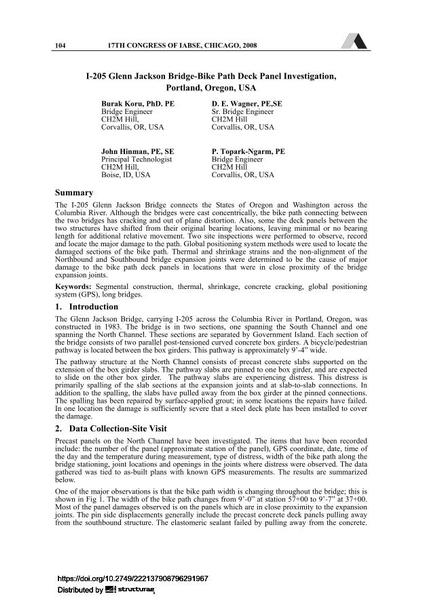I-205 Glenn Jackson Bridge-Bike Path Deck Panel Investigation, Portland, Oregon, USA

|
|
|||||||||||
Bibliografische Angaben
| Autor(en): |
Burak Koru
Donald E. Wagner John Hinman Pattanapong Topark Ngarm |
||||
|---|---|---|---|---|---|
| Medium: | Tagungsbeitrag | ||||
| Sprache(n): | Englisch | ||||
| Tagung: | 17th IABSE Congress: Creating and Renewing Urban Structures – Tall Buildings, Bridges and Infrastructure, Chicago, USA, 17-19 September 2008 | ||||
| Veröffentlicht in: | IABSE Congress Chicago 2008 | ||||
|
|||||
| Seite(n): | 104-105 | ||||
| Anzahl der Seiten (im PDF): | 6 | ||||
| Jahr: | 2008 | ||||
| DOI: | 10.2749/222137908796291967 | ||||
| Abstrakt: |
The I-205 Glenn Jackson Bridge is more than 11,000’ long and connects the States of Oregon and Washington across the Columbia River. The Northbound and Southbound bridge structures each include four travel lanes plus shoulders and provide one of the most important highways for the City of Portland and the region. The bridges provide access to Portland International Airport and many commuters use this highway for their daily travel. Both bridges include variable depth post- tensioned concrete box girders that were segmentally constructed in 1983. Span lengths vary with main spans of 600’. The Northbound and Southbound bridges are curved with varying radii over the 2 mile length. Although the bridges were cast concentrically, the bike path connecting between the two bridges has cracking and out of plane distortion, causing concrete to crack and spall, leading to holes forming at some locations. Also, some the deck panels between the two structures have shifted from their original bearing locations, leaving minimal or no bearing length for additional relative movement. At several locations, steel plates have been installed to maintain safe use of the path. Two site inspections were performed to observe, record and locate the major damage to the path. Global positioning system methods were used to locate the damaged sections of the bike path. This information was then linked to the structural analysis results. Thermal and shrinkage strains and the non-alignment of the Northbound and Southbound bridge expansion joints were determined to be the cause of major damage to the bike path deck panels in locations that were in close proximity of the bridge expansion joints. Several possible solutions to repair/alleviate the bike path damage were proposed to the Oregon DOT for their use. |
||||
| Stichwörter: |
Schwinden
|
||||
